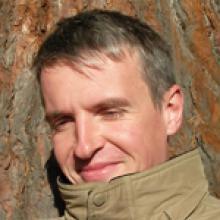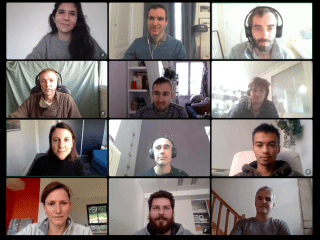The Cocoon Group
Members

Directeur de recherche
CNRS
Tel: 33 04 26 23 44 74

Chargé de recherche
CNRS
Tel: 04 72 43 29 09
Doctorant
UCBL
Tel: 04 72 44 81 42

Directeur de recherche
INRIA
Tel: 33 04 26 23 44 74
Le Cocon is both a research team and a think tank.
Research in “Le Cocon” team focuses on two main topics: multiscale evolution on one hand (i.e., studying the evolution of genetic systems while considering different levels -nucleotides, transposable elements, genes, genomes, microbiomes, organisms, populations, species, geography-), and environmental issues on the other hand. In both cases, we rely on modeling and data analysis, using a combination of statistics and computer science.
Le Cocon is also a place to think about the responsibilities of research and researchers in the anthropocene era, and about the role of non-researcher citizens in orienting and conducting research.
Multiscale evolution
- We have a long history of working on gene transfers. We develop new methods to detect these events in complex systems involving more than two levels (host, symbiont and parasites for example) and
- We use horizontal transfer detection to date species trees and to infer yet unknown biodiversity (extinct and unsampled) (Sthoriz (ANR, 2018)) .
- We have a lasting interest into convergent genomic evolution (Convergenomics - ANR, 2015)
- We question the usual way of testing bioinformatic methods (Evoluthon - ANR, 2019)
- We study the interaction between human populations, their lifestyles, and their gut microbiota (Microregal - ANR, 2015). We are notably interested in identifying cases of host-microbe coevolution and in better understanding transmission dynamics.
Environmental issues
- We develop computational methods to support an agriculture that relies on ecosystemic relationships between crops, the soil, its microbiota, and wild plants and animals (Community Garden Book - Inria, 2019)
- We develop statistical approaches to understand and predict crop yield variability with respect to meteorological conditions
Research in the anthropocene
- We participate to the science shop (UdL), the ethics platform (UdL), Labo1.5, the open science committee, Sciences Citoyennes, the shift project
- We organize a series of seminars to help us think about the position of scientific research in the history of the anthropocene, and about the position of scientists in the future of the anthropocene.
- We assemble committees of citizens to investigate to what extent scientific research can be democratized.
Teaching and outreach
- We teach at University of Lyon, University Lyon 1, INSA, Inria, ENS Lyon, we organize bioinformatics internships
- We regularly participate in the Fête de la Science, have contributed videos in the public transportation system in Lyon, give conferences at Université Populaire and contribute articles in general public journals.
- We develop the software Lifemap to explore the tree of life on computers and smartphones.
Prospective students and postdocs are invited to apply, as we often welcome visitors for internships or research projects.
Publications
Display of 181 to 210 publications on 222 in total
Multichromosomal Genome Median and Halving Problems
International Workshop on Algorithms in Bioinformatics (WABI) . 5251 : 1-13
Conference paper
see the publicationA Methodological Framework for the Reconstruction of Contiguous Regions of Ancestral Genomes and Its Application to Mammalian Genomes
PLoS Computational Biology . 4 : 391-410
Journal article
see the publicationSorting Signed Permutations by Reversal (Reversal Sequence) 2004; Tannier Sagot
incollection . -- : 860-863
Journal article
see the publicationIn response to comment on ‘A congruence index for testing topological similarity between trees’
Bioinformatics . 25 ( 1 ) : 150--151
Journal article
see the publicationSpeciation in fungi
Fungal Genetics and Biology . 45 ( 6 ) : 791--802
Journal article
see the publicationDémasquage des gènes spécifiques d'une espèce génomique du complexeAgrobacterium tumefaciens par AFLP et multicapteur à ADN
7. Colloque national du Bureau des Ressources Génétiques . 7
Conference paper
see the publicationDealing with incongruence in phylogenomic analyses
Philosophical Transactions of the Royal Society B: Biological Sciences . -- : 1233-1241
Journal article
see the publicationPrecise detection of rearrangement breakpoints in mammalian chromosomes
BMC Bioinformatics . 9 ( 1 ) : 286
Journal article
see the publicationReactive Stochastic Local Search Algorithms for the Genomic Median Problem
European Conference on Evolutionary Computation in Combinatorial Optimization (EvoCOP) . 4972 : 266-276
Conference paper
see the publicationA Methodological Framework for the Reconstruction of Contiguous Regions of Ancestral Genomes and its Application to Mammalian Genomes
: 26
Report
see the publicationThe solution space of sorting by reversals
3rd International Symposium on Bioinformatics Research and Applications (ISBRA 2007) . 4463 : 293-304
Conference paper
see the publicationEvolution under Reversals: Parsimony and Conservation of Common Intervals
IEEE/ACM Transactions on Computational Biology and Bioinformatics . 4 : 301-309
Journal article
see the publicationAdvances on sorting by reversals
Discrete Applied Mathematics . 155 : 881-888
Journal article
see the publicationA congruence index for testing topological similarity between trees
Bioinformatics . 23 ( 23 ) : 3119--3124
Journal article
see the publicationWhen can host shifts produce congruent host and parasite phylogenies? A simulation approach
Journal of Evolutionary Biology . 20 ( 4 ) : 1428--1438
Journal article
see the publicationComparative genomics and the evolution of prokaryotes
Trends in Microbiology . 15 : 135-141
Journal article
see the publicationGenome characteristics of facultatively symbiotic Frankia sp. strains reflect host range and host plant biogeography
Genome Research . 17 : 7-15
DOI: 10.1101/gr.5798407
Journal article
see the publicationEffective Stochastic Local Search Algorithms for the Genomic Median Problem
Doctoral Symposium on Engineering Stochastic Local Search Algorithms (SLS-DS) . : 1-5
Conference paper
see the publicationGlobal trends of whole-genome duplications revealed by the ciliate Paramecium tetraurelia.
Nature . 444 ( 7116 ) : 171-8
DOI: 10.1038/nature05230
Journal article
see the publicationEvolutionary origins of genomic repertoires in bacteria
PLoS Biology . 3 : 0807-0814
Journal article
see the publicationA bunch of fun-guys: the whole-genome view of yeast evolution
Trends in Genetics . 21 : 1-3
Journal article
see the publicationExamining bacterial species under the specter of gene transfer and exchange
Proceedings of the National Academy of Sciences of the United States of America . 102 : 6595-6599
Journal article
see the publicationPerfect sorting by reversals
International Computing and Combinatorics Conference . 3595 : 42-51
DOI: 10.1007/11533719_7
Conference paper
see the publicationComment on "The origins of genome complexity
Science . 306 : 978a-978a
Journal article
see the publicationDetecting phylogenetic incongruence using BIONJ: an improvement of the ILD test
Molecular Phylogenetics and Evolution . 33 : 687-693
Journal article
see the publicationOn Metric Generators of Graphs
Mathematics of Operations Research . 29 : 383-393
Journal article
see the publicationBacterial genomes as new gene homes: the genealogy of ORFans in E. coli
Genome Research . 14 : 1036-1042
Journal article
see the publicationStart-up entities in the origin of new genes
Current Opinion in Genetics and Development . 14 : 616-619
Journal article
see the publication
